Affiliate disclosure: This post may contain affiliate links. Please see our Privacy Policy.
Hedgehog mushrooms (Hydnum sp.) are delicious, easy-to-identify mushrooms perfect for beginning foragers.
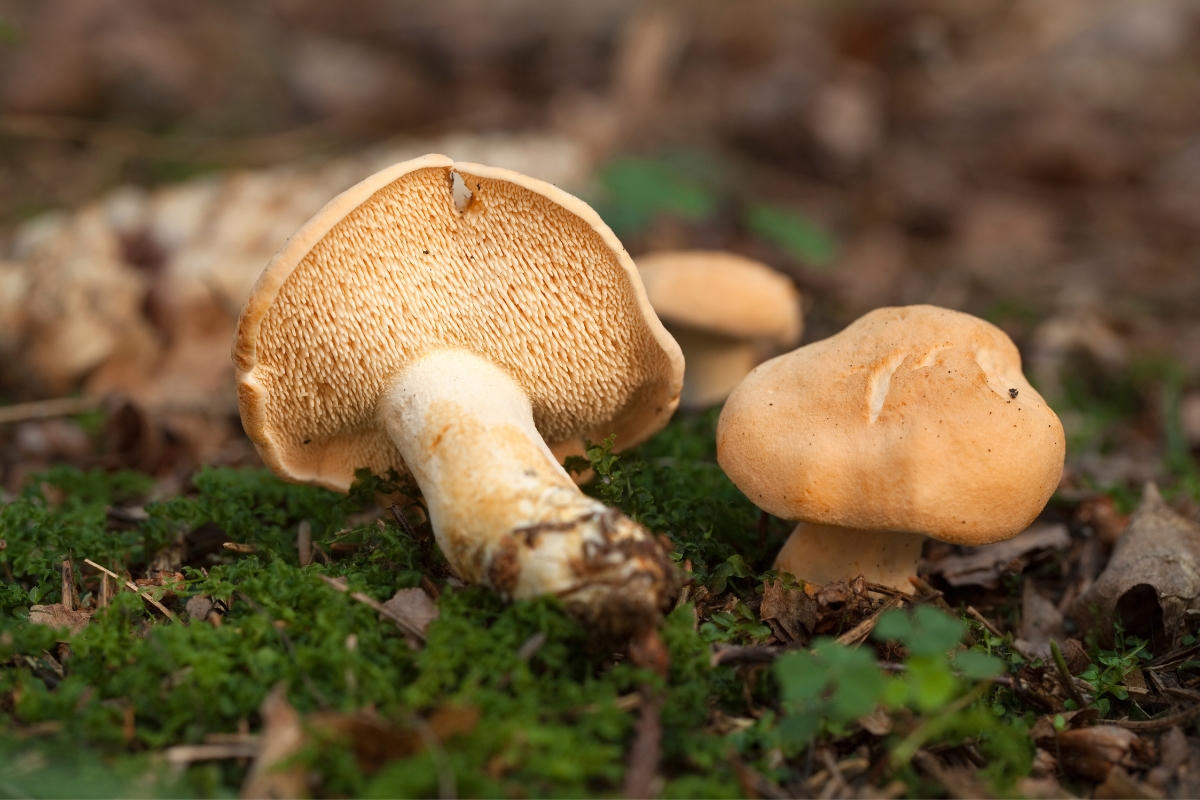
This article was written by Timo Mendez, a freelance writer and amateur mycologist who has foraged wild mushrooms worldwide.
Sweet Tooth, Hedgies, Belly Buttons, and Sheep’s Foot are all common names for a gourmet edible mushroom best known as the Hedgehog Mushroom. The names are all descriptive in their own way, as the mushrooms have a spikey gill surface (a bit like hedgehogs or hedgies), and they’re sweet tasting (thus, sweet tooth). The shape can be a bit irregular, leading to the names belly buttons and sheep’s foot too.
These easy-to-identify mushrooms are perfect for beginners. They’re incredibly delicious, with a flavor somewhat like sweet mild chanterelles, and they have no close look likes.
Add in the fact that they’re relatively common all across the US (and the world), and you’ve got the perfect mushroom for beginning foragers.
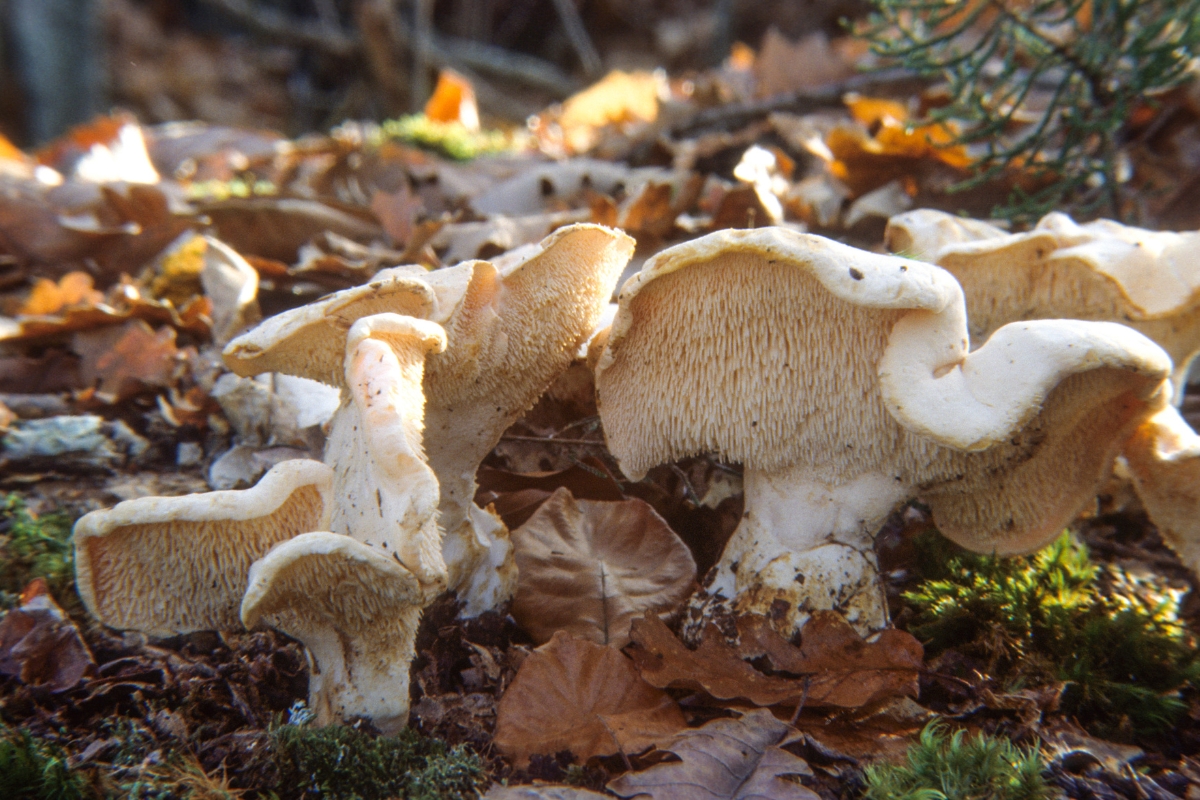
How To Forage For Hedgehog Mushrooms
Hedgehogs are not only easy to identify, but everything about them is simple to forage. Their light pale color makes them visible from afar, and their wide distribution means they likely occur in the woods near you. In many places, they also have pretty long seasons and opportunistically appear whenever conditions are right.
That said, Hedgehogs are much more prolific in some regions than others.
Another thing to consider is that the common name “Hedgehog” actually encompasses several closely related species in the genus Hydnum. Due to their close resemblance, almost all the hedgehogs were historically classified scientifically as Hydnum repandum but developments in the field of mycology led to the recognition of different species.
As of 2018, scientists have recognized at least 49 different species of hedgehog mushrooms! These each have their unique ecology and morphological differences. Do not let this diversity overwhelm or scare you though! Despite technically being different, they are all edible and easily recognized as hedgehogs. As a casual forager, there’s no real reason to differentiate between the species (beyond satisfying your own curiosity).
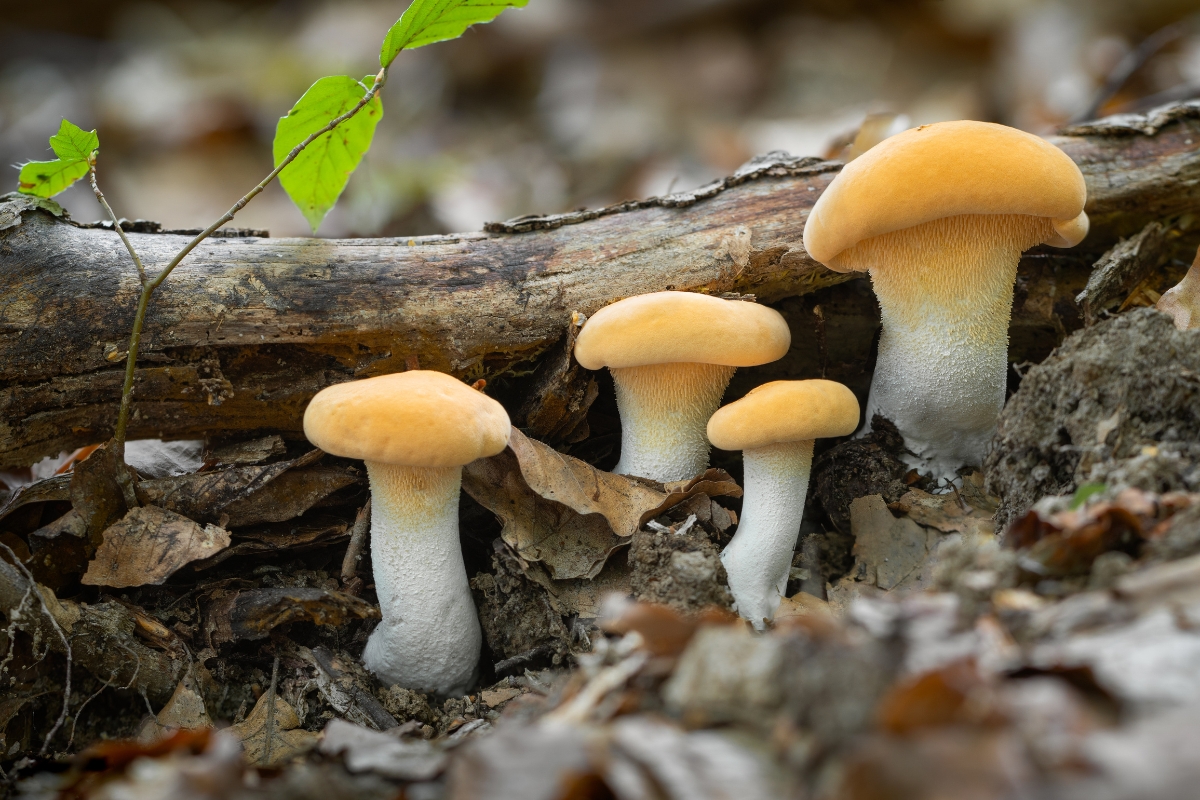
Common Hedgehog Mushroom Species
While there are dozens of species of hedgehog mushrooms, here are some of the most common:
- Hydnum repandum – This is the classic hedgehog mushroom that was originally thought to occur worldwide. Now it is only recognized to occur in Europe despite the name still being commonly used and present in literature.
- Hydnum washingtonianum – This is a name now often used for the North American hedgehog mushrooms. It is synonymous with Hydnum neorepandum
- Hydnum umbilicatum – The “Belly Button Hedgehog” native to eastern North America.
- Hydnum oregonense – This is the “Belly Button Hedgehog” that is native to western North America.
- Hydnum rufescens – This is known as the “Terracotta Hedgehog,” and it is native to Europe.
- Hydnum albidum – This species is similar to Hydnum repandum, but completely white.
Note: Due to the nature of science and the recent advancements in genetic tools, scientific names are liable to change. For most foragers, the details of the Latin binomial are not important, though!
Finding Host Trees
Like many gourmet mushrooms, Hedgehogs only grow in strict symbiotic relationships with the roots of host plants. Plants give photosynthetically derived sugars to the underground fungal network in exchange for nutrients, water, and other beneficial services. These sugars are the sole source of carbon for the mushroom.
Since these relationships are often exclusive between specific plant/mushroom species, experienced foragers utilize trees as the biggest clue to finding good spots. Knowing tree identification and the best host for mushrooms in your region is one of the most important things to know.
In the case of Hedgehog mushrooms, there is a particularly wide range of hosts, including Oak, Beech, Pine, Spruce, Douglas Fir, Hemlock, Eucalyptus, true Fir, Chestnut, and other hardwood tree species. Hedgehogs may be exclusive to one or two hosts in some regions.

Where Do You Find Hedgehog Mushrooms?
Hedgehogs are well distributed in deciduous and coniferous forests of the northern hemisphere. They often occur in groups, and occasionally in fairy rings or lines near their host trees.
In deciduous forests, they often peek out from the leaf litter, while in coniferous forests it is not uncommon to find them growing in mossy environments. You can also find hedgehogs growing on steep banks near roadsides or streams.
They are pretty diverse regarding the different host trees they associate with, although this changes depending on the region.
Eastern United States and Canada
In the eastern United States and Canada, Hedgehogs mostly occur in deciduous or mixed forests. Their host preferences include Beech and Oak, although they occur with other tree species.
They are prominent in the Great Lakes region, and the Appalachian mountains and become more common as you go northeast into Maine and southern Canada.
In the south along the gulf, Hedgehog occur predominantly with pine.
Western United States and Canada
In the western United States and Canada, hedgehogs grow mostly with conifers such as Spruce and Douglas Fir.
In California, they are most prominent in the coast ranges north of Santa Cruz, occurring with Bishop Pine, Sitka Spruce, Hemlock, and Douglas Fir.
Hedgehogs occur, but are uncommon, in the Sierra Nevadas. As you go north into Oregon and Washington, you continue to find them abundantly along the coast, but the range extends east into the cascades.
In western Canada, the range extends east into the Rockies and goes north well into Alaska. Hedgehogs also occur in the Colorado Rockies above 9,000 ft in mixed spruce/fir forests, although they are considered rare.
Europe
Hedgehogs are common in Europe and widespread with a range that stretches into Asia. They are found as far north as Finland and south down to Portugal and Greece.
In central Europe, they most often occur with Beech and Oak, whereas in the north, they begin associating with Norway Spruce.
In southern Europe, they can be found with Pine, and it is not uncommon to find them in Eucalyptus plantations.
Other Regions
Hedgehog mushrooms also occur in Asia and are associated with similar tree species in Europe. Hedgehogs are also found in the montane oak forests of Mexico, Central America, and down into northern Colombia.
They are also known from the mountainous regions of Morocco and other parts of northern Africa.
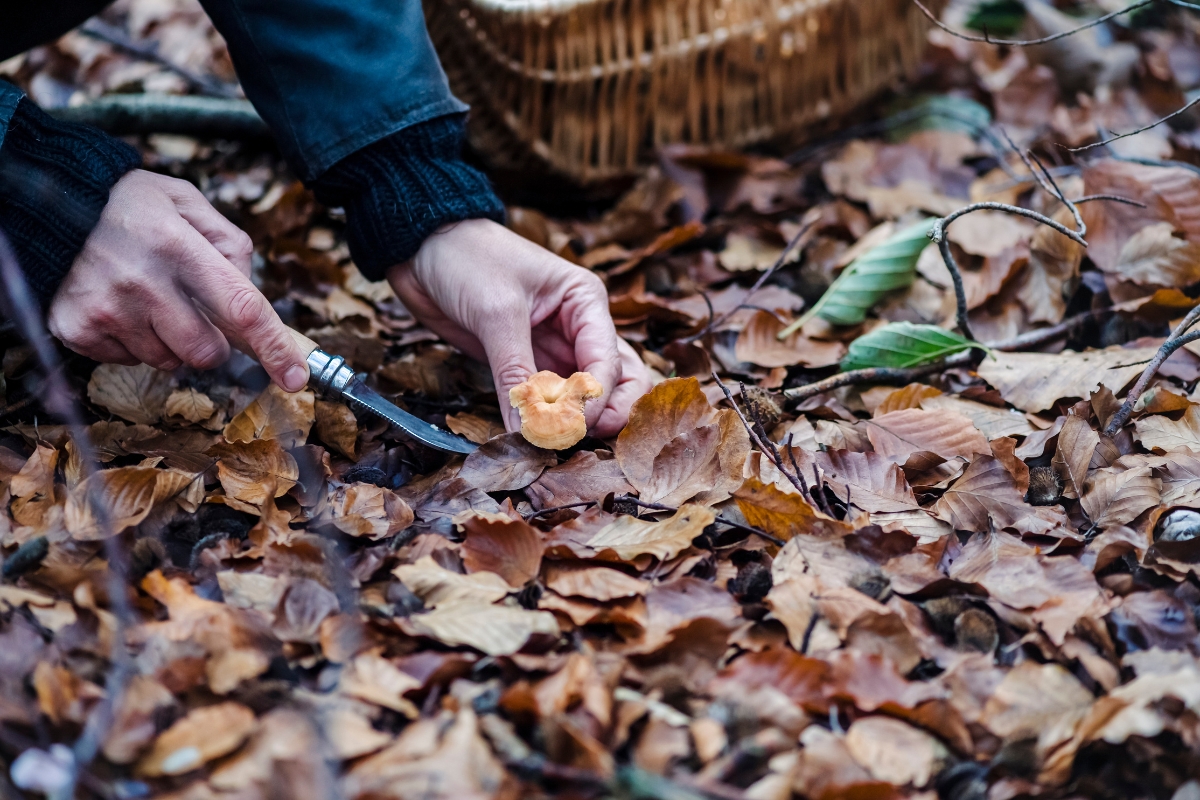
When Is Hedgehog Mushroom Season?
Hedgehogs are often late-season mushrooms and notorious for their tolerance to colder temperatures. In some parts of their range, they are some of the last mushrooms fruiting, sometimes well past the first frosts of the season. In areas with mild winters, they can occur all winter long and continue fruiting into the spring.
Eastern North America (July-November) ~ They are often triggered by cooling temperatures and often fruit in northern latitudes and higher elevations first. In parts with mild winters, this can be stretched into January.
Western North America (July-Feburary)~ Hedgehogs here can fruit as early as July on the coast, thanks to the abundance of fog. Inland the season starts more in the fall and can easily stretch into February. These are classic fall and winter mushrooms. Belly Button hedgehogs tend to be more abundant during the winter, while Giant Hedgehogs occur in late summer, fall, and occasionally in spring.
Europe (August-December)~ In Europe, Hedgehogs typically grow from August to December in late summer or winter. Their season typically starts with dropping temperatures, earlier in northern latitudes and progressively later as you go south. In western Europe and regions with continental climates, the peak season is typically around October. In Spain and Portugal, December or January can be excellent times for Hedgehogs, given there is adequate rain.
Mexico and Central America (June-September)~ In central America, hedgehog mushrooms grow with the summer monsoon season. They can start as soon as the rains begin in June and usually stop growing by the end of the rainy season in September.
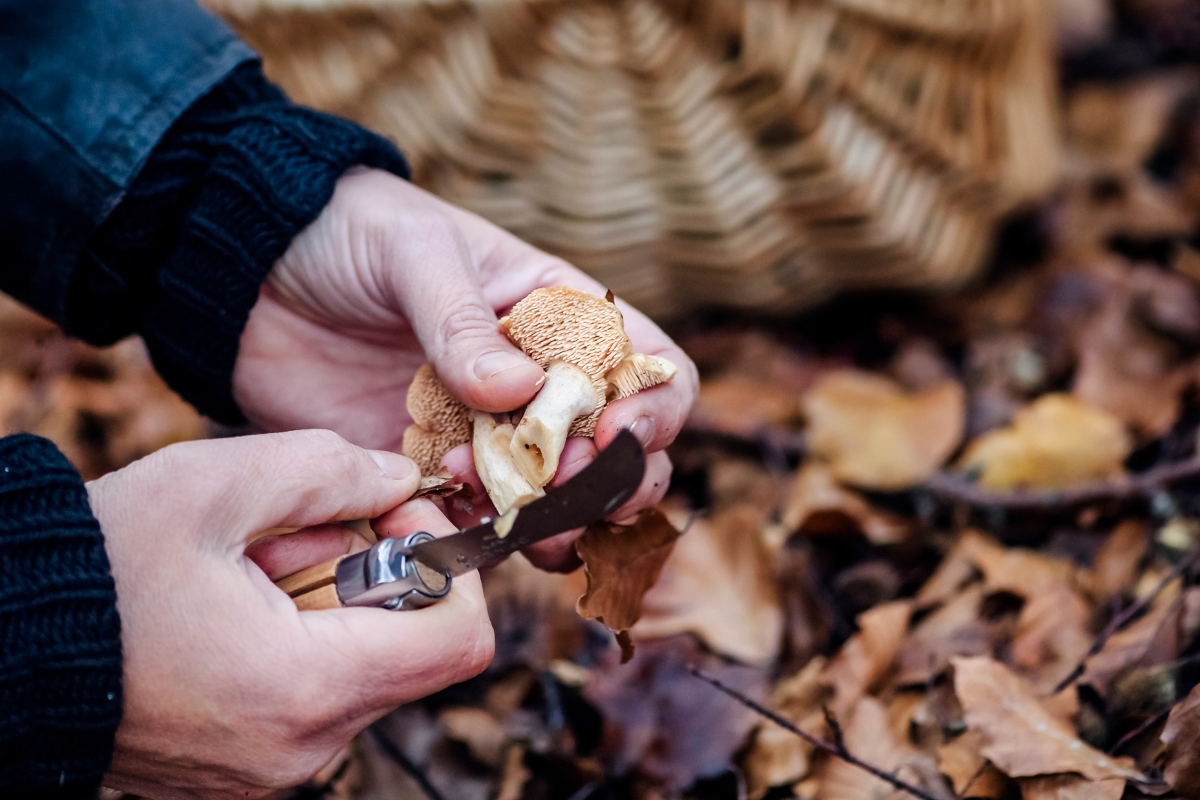
Identifying Hedgehog Mushrooms
While there are different types of Hedgehog mushrooms, they all share very similar features characteristic to the group. While it may not always be so easy to tell exactly what type you have, just knowing that you have a Hedgehog mushroom is easy.
Hedgehogs are generally light in color, often a peachy pale yellow, although some varieties have a darker almost brown tone. The coloration is most prevalent in specimens that have been exposed to sunlight, while those hidden beneath vegetation or leaf litter have more pale to white coloring. Bruising results in a darker orange tone.
The cap is spherical and often with a cleavage on one side, giving it a hoof-like appearance. This gives rise to the common name “Sheeps Foot,” which is the English translation of many traditional European names. The margin is usually enrolled in younger specimens and flattens out as they age.
Above all, the most distinct feature of the hedgehog mushroom is the “spines” or “teeth” that densely cover the underside of the cap. These give rise to the common names I promised to explain earlier in the text. These grow to be about a quarter inch in length and occasionally run down the stem. They are pale in color, brittle, and easily detached with the force of a finger. Despite being called the “Sweet Tooth Mushroom”, these “teeth” are a bit bitter.
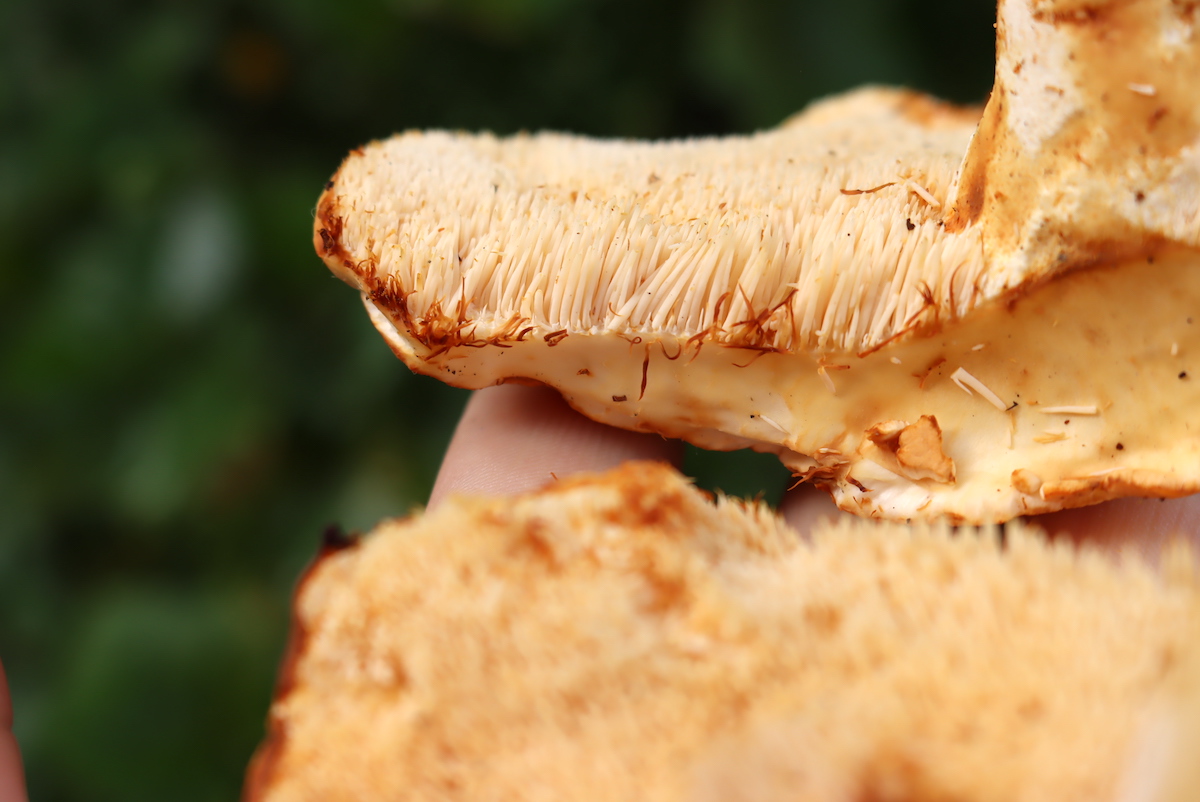
Once you familiarize yourself with these spines, there is no mistaking a hedgehog mushroom. All species and varieties of hedgehogs have these same distinctive spines. Some differences in the varieties include:
- The classic Hedgehogs, such as Hydnum repandum, have a stem that usually grows at an angle and is positioned off-center or on the edge of the cap. This group has the largest size of all hedgehogs.
- The “Belly Button Hedge Hogs” are small and have a depressed belly button-like hole at the center of the cap.
- The “Terracotta Hedgehog” is easily identified by its smaller stature and darker brown coloration.
Hedgehog Mushroom Identification Guide
- Pale white to peach color that bruises orange/brown
- Cleavage “hood-shaped” cap
- The bottom of the cap is densely covered with small spines (>1/4”)
- The texture is cork-like and rubbery
- Stem often angled and off-center
- Belly Button Hedgehogs are smaller and have a depressed central “belly button”
Hedgehog Mushroom Look-Alikes
While there aren’t any true look-alikes, there are at least two mushrooms that vaguely resemble hedgehog mushrooms.
- Hawks Wing – This is one of the only mushrooms with spines that bares some resemblance to the hedgehog mushroom. The main difference is that these have a dark coloring and a scaly top. One variety, Sarcodon imbricatus also known as Hawks Wings, is also a revered edible. Many of these species are very bitter.
- Drab Tooth – Also known as Bankera fuligineoalba, this mushroom also has similar spines. It is much tougher in texture than hedgehogs and has a dark-colored cap and stems. The underside of the cap and stem is white.
How To Harvest Hedgehog Mushrooms
Like harvesting any wild-food item, it is important to have respect for the forest and all its inhabitants. Make sure to respect property owners and avoid harvesting from areas where it is prohibited, or there are sensitive species present. Do not leave trash, and ideally, pick some up on your way out. Ideally, harvest your mushrooms with a basket or porous bag to allow the spores to disperse as you walk through the woods.
It is recommended to remove all the dirt from your mushroom with a knife or brush before placing them in your bag or basket. This avoids spreading dirt all over your mushrooms, particularly within the spines, which are difficult to clean. Most pickers just cut off the entire stem butts, which tend to be the dirtiest parts of the mushroom.
Avoid harvesting mushrooms that are too old and have begun to rot. These are not only unpleasant to eat but could cause digestive issues.
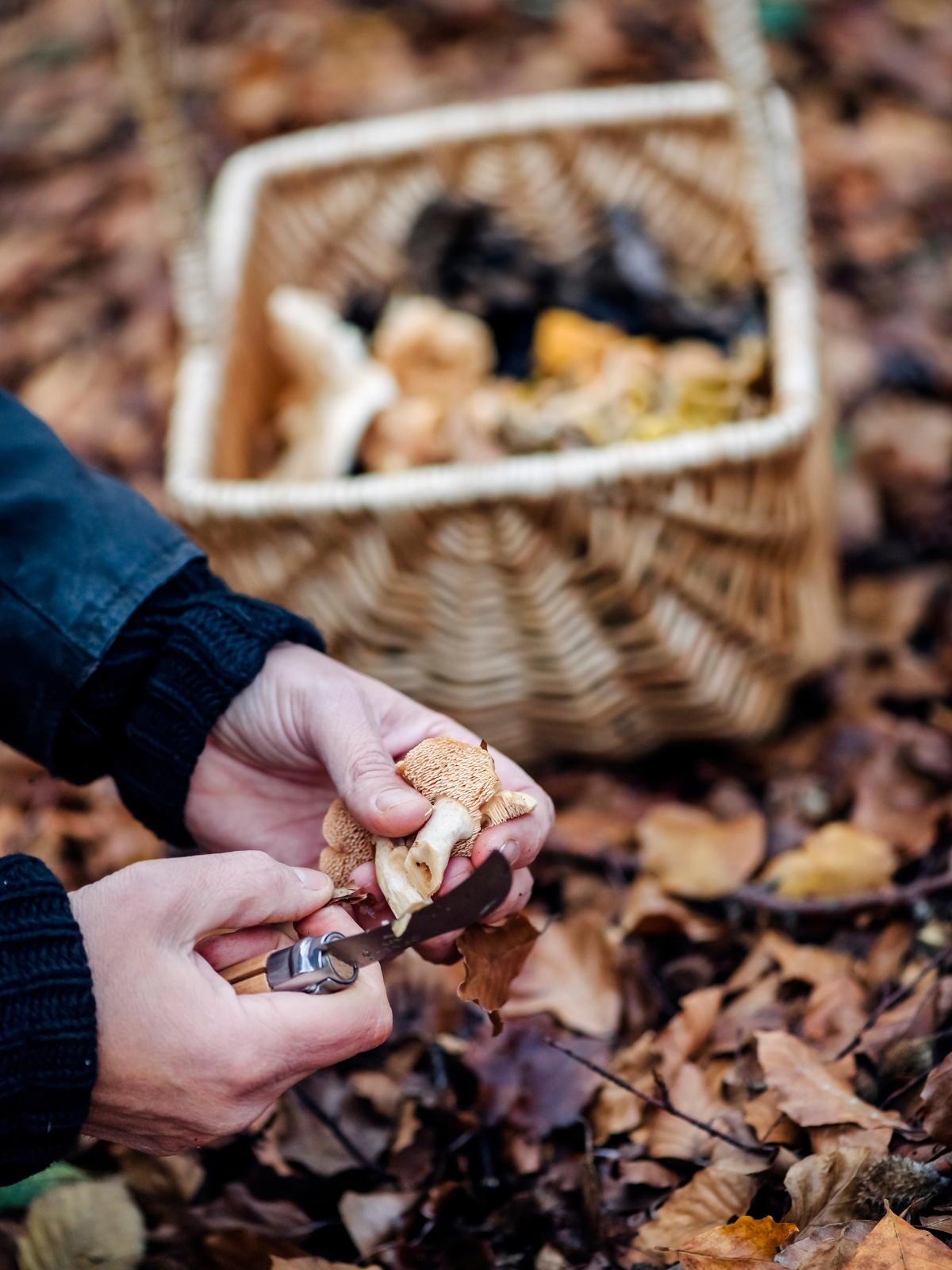
Cooking With Hedgehog Mushrooms
Hedgehogs are delicious and versatile mushrooms. There are a million ways to cook them, and they pair well with almost any type of dish. They can be the main ingredient in a recipe, infused into a delightful sauce, or paired alongside meat and veggies. They can also be used simply as a scrumptious topping! This being said, to most appreciate the subtle flavor, it is best to pair it with simple ingredients that help carry its delicate taste.
Generally speaking, Hedgehogs are paired great with simple dishes that have little to no spices. They are well accented with cream sauces or cheese, and their flavor can be enhanced with a bit of garlic or parsley. They go great with pasta, omelets, risotto, or in a stew. Another one of my favorite recipes is adding sauteed Hedgehogs into a grilled cheese made with real cheddar or mozzarella! If you are cooking them for the first time, it is best to start with something simple to familiarize yourself with the flavor.
Unless you’ve harvested Hedgehogs during a relatively dry period, it is recommended to conduct a “dry saute” when cooking them. This process helps enhance the texture of the water-saturated mushroom. To do this, simply dice the mushrooms as preferred, then add them into a hot pan with no oil or butter. The water will naturally be released from the mushroom and begin to evaporate. Once all the water has evaporated, add oil or butter and saute as desired.
Another thing to note is that some people experience a bitter flavor when eating Hedgehog mushrooms. I haven’t personally ever felt this to be an issue, but I’ve met a handful of people who are displeased by it. To reduce this sensation, it is recommended to remove all the spines on the underside of the cap. This is where a lot of the bitter flavor is concentrated. Removing the spines can easily be done with the force of your finger or with a spoon.
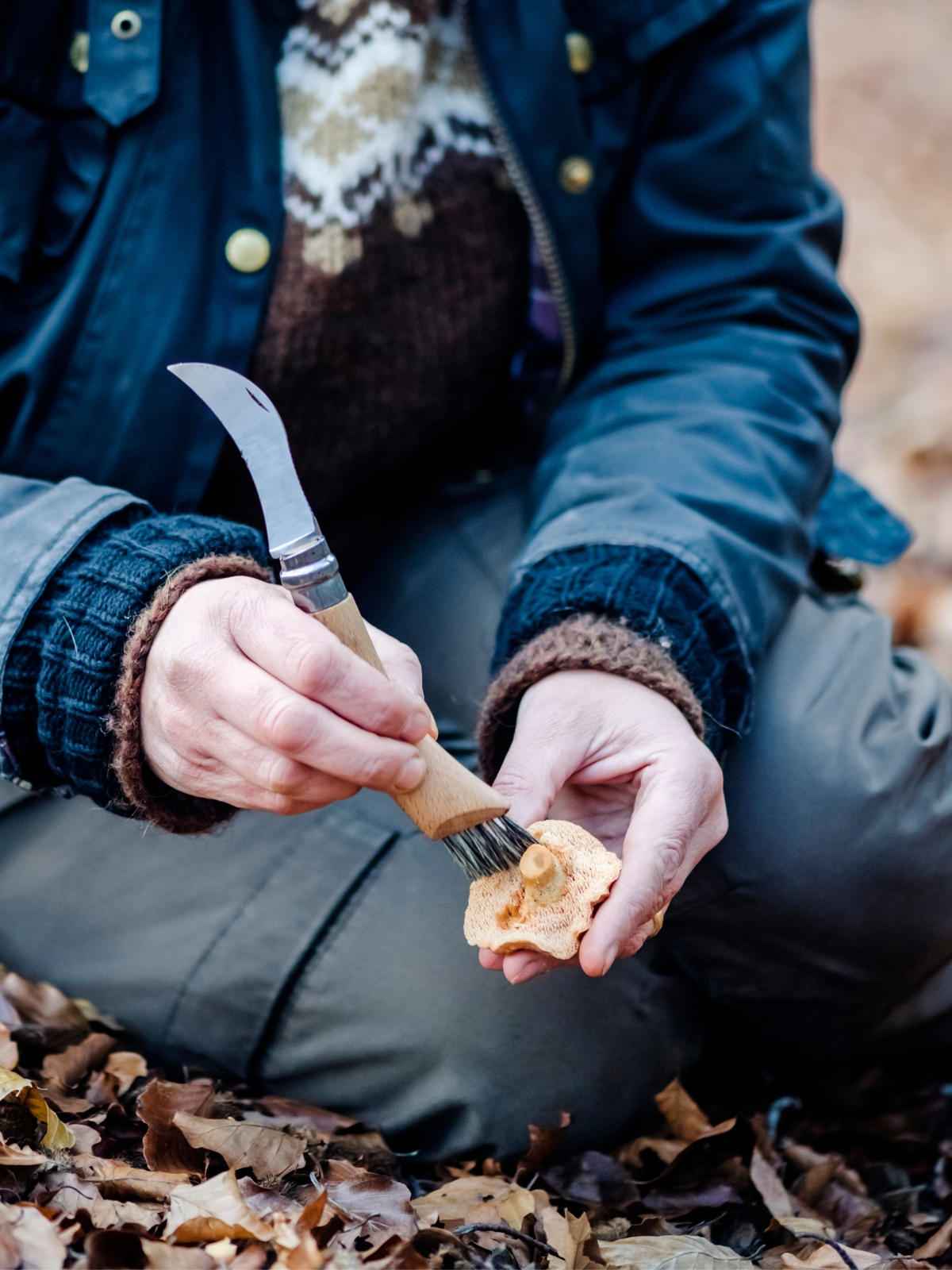
Preserving Hedgehog Mushrooms
Hedgehog mushrooms can be preserved in various ways, but perhaps the best and most versatile is freezing. To do this, simply saute them as desired, wait for them to cool down, then place them into your freezer. Do not freeze them raw as you’ll end up with an unappetizing gooey texture!
If freezing isn’t an option for you, there are other options. Unfortunately, they are not well suited for drying because they do not rehydrate well. The texture ends up a bit rubbery and tough, and they become tough to digest. This being said, they can be powdered and make a great condiment. Another option is to simply parboil them for about 5 minutes, then add them to any pickle recipe you desire!
Mushroom Foraging Guides
Looking for a few more mushroom foraging guides to keep you busy in the woods this season?
- Morel Mushrooms
- Chaga Mushrooms
- Birch Polypore
- Tinder Polypore
- Witches Butter Mushrooms
- Puffball Mushrooms
- Shaggy Mane Mushrooms
- Reishi Mushrooms
- Turkey Tail Mushrooms
- Dryad’s Saddle


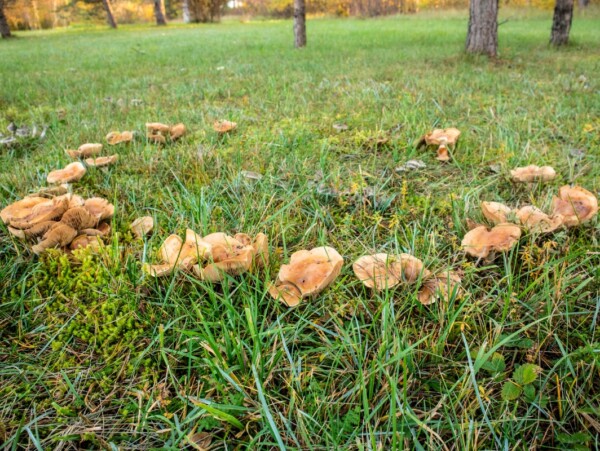
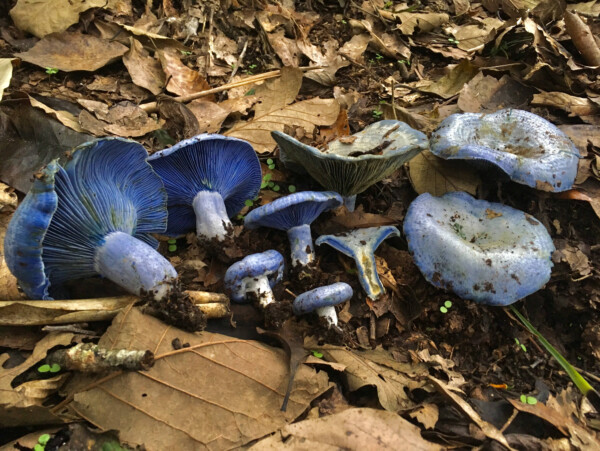
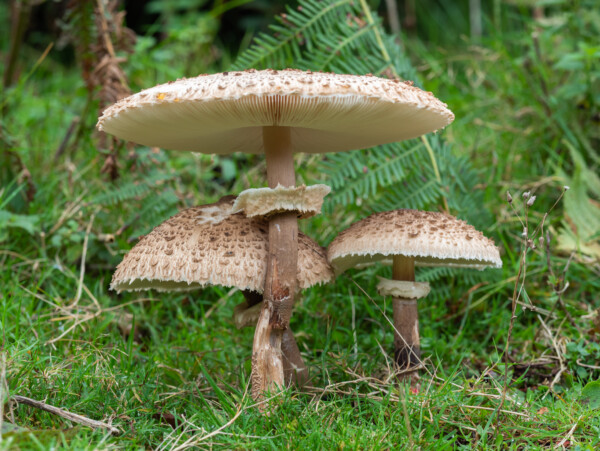










thank you for this article